|
|
| (32 intermediate revisions by the same user not shown) |
| Line 1: |
Line 1: |
| == Syntax 1 Wiki ==
| | [[Syntax_1_Wiki|Syntax 1 Wiki]] |
|
| |
|
| | [[Constraint-based_Syntax_2|Syntax 2]] |
|
| |
|
| <font face="Arial, Helvetica, sans-serif">
| |
| <font size="3">
| |
|
| |
|
|
| |
|
| | [[Grammar-Writing|Grammar Writing]] |
|
| |
|
| [[Words|Words]] | | [[GS-2000|Ginzburg and Sag (2000)]] |
|
| |
|
| ==The Negative Marker Not==
| | [[HPSG|Head-Driven Phrase Structure Grammar]] |
| Can follow a finite auxiliary to negate a sentence, but not a finite verb.
| |
| I should not have said that.
| |
| * I not slept well last night.
| |
| Can precede any major phrase for so-called constituent negation.
| |
| NP: Pat read not [NP: this book] but the other one.
| |
| VP: Chris is likely not [VP: to get the scholarship]
| |
| PP: Sandy put the book not [PP: on the shelf] but next to it.
| |
| Forms: not, n't (when cliticised to an auxiliary)
| |
|
| |
|
| | [[Syntax_1_Wiki_Aenderungen|Syntax 1 Wiki: Änderungen]] |
|
| |
|
|
| |
|
| | <center> |
| | <embedvideo service="youtube" dimensions="400">https://www.youtube.com/watch?v=JRiX8Jiq_Z4</embedvideo> |
| | </center> |
|
| |
|
|
| |
|
| | [ Parts of the clause] |
|
| |
|
| | <!-- This is a comment --> |
| | ∀''x'' ('''cat'''(''x'') : ∃''y''('''likes(''y'', ''x'')) |
| | ⊃ ∧ ¬ ∨ ≡ ∀ ∃ æ ⊕ Ø ⇒ <u>Unterstrichen</u> → ⇒ |
| | |
| | Text davor |
| | <blockquote>Blockquote</blockquote> |
| | Text danach |
|
| |
|
|
| |
|
|
| |
|
| | <font face="Arial, Helvetica, sans-serif"> |
| | <font size="3"> |
|
| |
|
| <quiz display=simple>
| | Font size 3 |
| {Determine the part of speech of the words in the sentence.<br /> Use the following part of speech labels: A, Adv, Cj, C, D, N, P, V
| |
| |type="{}"}
| |
| | |
| Alex/{ N _5 } talked/{ V _5 } to/{ P _5 } my/{ D _5 } best/{ A _5 } friend/{ N _5 }.
| |
| || Solution: N V P D A N
| |
| </quiz>
| |
| | |
| <quiz display=simple>
| |
| {Determine the part of speech of the words in the sentence.<br />Use the following part of speech labels: A, Adv, Cj, C, D, N, P, V
| |
| |type="{}"}
| |
| | |
| You/{ N _5 } might/{ V _5 } suspect/{ V _5 } that/{ C _5 } Pat/{ N _5 } is/{ V _5 } a/{ D _3 } genius/{ N _5}.
| |
| || Solution: N V V C N V D N
| |
| </quiz>
| |
| | |
| <quiz display=simple>
| |
| {Determine the part of speech of the words in the sentence.<br />Use the following part of speech labels: A, Adv, Cj, C, D, N, P, V
| |
| |type="{}"}
| |
| | |
| The/{ D _5} title/{ N _5 } of/{ P _5 } a/{ D _5 } book/{ N _5 } largely/{ Adv _5 }
| |
| || Solution: D N P D N Adv V
| |
| | |
| determines/{ V _5 } whether/{ C _5 } it/{ N _5 } will/{ V _5 } be/{ V _5 } successful/{ A _5 } or/{ Cj _5 } a/{ D _5 } flop/{ N _5 }.
| |
| || Solution: V C N V V A Cj D N
| |
| </quiz>
| |
| | |
| === Semantic analysis of sentences into predicates and arguments ===
| |
| | |
| Note: Many of the sentences in this section are taken from or based on examples in Hornby, A.S. (1975) Guide to Patterns and Usage in English. Second Edition. Cornelsen & Oxford University Press.
| |
| | |
| <quiz display=simple>
| |
| { Fill in the gaps!
| |
| | |
| ''Example:'' <span style="color: blue>You <u>surprised</u> them.</span>
| |
| | type="{}" }
| |
| | |
| Predicate: { x surprises y _15}
| |
| | |
| x = { You _10}
| |
| y = { them _10}
| |
| z = { - _10}
| |
| </quiz>
| |
| | |
| <quiz display=simple>
| |
| { Fill in the gaps!
| |
| | |
| ''Example:'' <span style="color: blue>We went to Wales.</span>
| |
| | type="{}" }
| |
| | |
| Predicate: { x goes y _15}
| |
| | |
| x = { We _10}
| |
| y = { Wales _10}
| |
| z = { - _10}
| |
| </quiz>
| |
| | |
| | |
| <quiz display=simple>
| |
| { Fill in the gaps!
| |
| | |
| ''Example:'' <span style="color: blue>The plane landed.</span>
| |
| | type="{}" }
| |
| | |
| Predicate: { x landed _15}
| |
| | |
| x = { The plane _10}
| |
| y = { - _10}
| |
| z = { - _10}
| |
| </quiz>
| |
| | |
| <quiz display=simple>
| |
| { Fill in the gaps!
| |
| | |
| ''Example:'' <span style="color: blue>Steven met my most favorite teacher.</span>
| |
| | type="{}" }
| |
| | |
| Predicate: { x meets y _15}
| |
| | |
| x = { Steven _10}
| |
| y = { my most favorite teacher_30}
| |
| z = { - _10}
| |
| </quiz>
| |
| | |
| <quiz display=simple>
| |
| { Fill in the gaps!
| |
| | |
| ''Example:'' <span style="color: blue>She said that it would rain.</span>
| |
| | type="{}" }
| |
| | |
| Predicate: { x says y _15}
| |
| | |
| x = { She _10}
| |
| y = { that it would rain _25}
| |
| z = { - _10}
| |
| </quiz>
| |
| | |
| <quiz display=simple>
| |
| { Fill in the gaps!
| |
| | |
| ''Example:'' <span style="color: blue>Many of his friends consider Joe somewhat arrogant.</span>
| |
| | type="{}" }
| |
| | |
| Predicate: { x consider y z _15}
| |
| | |
| x = { Many of his friends _25}
| |
| y = { Joe _10}
| |
| z = { somewhat arrogant _20}
| |
| </quiz>
| |
| | |
| | |
| <quiz display=simple>
| |
| { Fill in the gaps!
| |
| | |
| ''Example:'' <span style="color: blue>We need to talk to Lilly about her behavior.</span>
| |
| | type="{}" }
| |
|
| |
|
| Predicate: { x talk y z _15}
| | </font> |
|
| |
|
| x = { We _10}
| | <span style="color: red>Text color</span> |
| y = { to Lilly _10}
| |
| z = { about her behavior _20}
| |
| </quiz> | |
|
| |
|
| <quiz display=simple> | | [<sub>NP</sub> labeled brackets ] |
| { Fill in the gaps!
| |
|
| |
|
| ''Example:'' <span style="color: blue>The plane landed.</span>
| | Superscripts<sup>1</sup> |
| | type="{}" }
| |
|
| |
|
| Predicate: { x lands _15}
| | Definitionsliste: |
|
| |
|
| x = { The plane _10}
| | ;Begriff 1 |
| y = { - _10}
| | : Beschreibung 1 |
| z = { - _10}
| | ;Begriff 2 |
| </quiz>
| | : Beschreibung 2-1 |
| | : Beschreibung 2-2 |
|
| |
|
| | Text einrücken: |
|
| |
|
| <quiz display=simple>
| | : Einfache Einrückung |
| { Fill in the gaps!
| | :: Doppelte Einrückung |
| | ::::: Mehrfache Einrückung |
|
| |
|
| ''Example:'' <span style="color: blue>I talked to her.</span>
| | Nummered list: |
| | type="{}" }
| |
|
| |
|
| Predicate: { x talks y _15}
| | # Erstes Element der ersten Ebene |
| | ## Erstes Element der zweiten Ebene |
| | ## Zweites Element der zweiten Ebene |
| | # Zweites Element |
|
| |
|
| x = { I _10}
| | Bulleted lists: |
| y = { to her _10}
| |
| z = { - _10}
| |
| </quiz>
| |
|
| |
|
| | * Erstes Element der ersten Ebene |
| | ** Erstes Element der zweiten Ebene |
| | ** Zweites Element der zweiten Ebene |
| | * Zweites Element |
|
| |
|
| <quiz display=simple>
| |
| { Fill in the gaps!
| |
|
| |
|
| ''Example:'' <span style="color: blue>We gave Lilly a bike.</span>
| |
| | type="{}" }
| |
|
| |
|
| Predicate: { x gives y z _15}
| |
|
| |
|
| x = { We _10}
| | [[File:employees.jpg]] |
| y = { Lilly _10}
| | [[File:books.jpg]] |
| z = { bike _10}
| | [[File:iphones.png]] |
| </quiz>
| | [[File:pos-jpg.jpg]] |
| | [[File:pos-v-1.jpg]] |
| | [[File:pos-v-2.jpg]] |
|
| |
|
| <quiz display=simple>
| |
| { Fill in the gaps!
| |
|
| |
|
| ''Example:'' <span style="color: blue>Someone pushed Lilly into the flowers.</span>
| |
| | type="{}" }
| |
|
| |
|
| Predicate: { x pushes y z _15}
| |
|
| |
|
| x = { Someone _10}
| |
| y = { Lilly _10}
| |
| z = { into the flowers _20}
| |
| </quiz>
| |
|
| |
|
|
| |
|
Syntax 1 Wiki
Syntax 2
Grammar Writing
Ginzburg and Sag (2000)
Head-Driven Phrase Structure Grammar
Syntax 1 Wiki: Änderungen
[ Parts of the clause]
∀x (cat(x) : ∃y(likes(y, x))
⊃ ∧ ¬ ∨ ≡ ∀ ∃ æ ⊕ Ø ⇒ Unterstrichen → ⇒
Text davor
Blockquote
Text danach
Font size 3
Text color
[NP labeled brackets ]
Superscripts1
Definitionsliste:
- Begriff 1
- Beschreibung 1
- Begriff 2
- Beschreibung 2-1
- Beschreibung 2-2
Text einrücken:
- Einfache Einrückung
- Doppelte Einrückung
- Mehrfache Einrückung
Nummered list:
- Erstes Element der ersten Ebene
- Erstes Element der zweiten Ebene
- Zweites Element der zweiten Ebene
- Zweites Element
Bulleted lists:
- Erstes Element der ersten Ebene
- Erstes Element der zweiten Ebene
- Zweites Element der zweiten Ebene
- Zweites Element
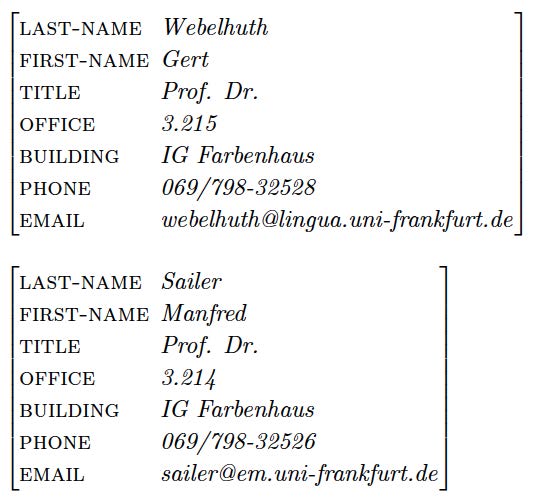
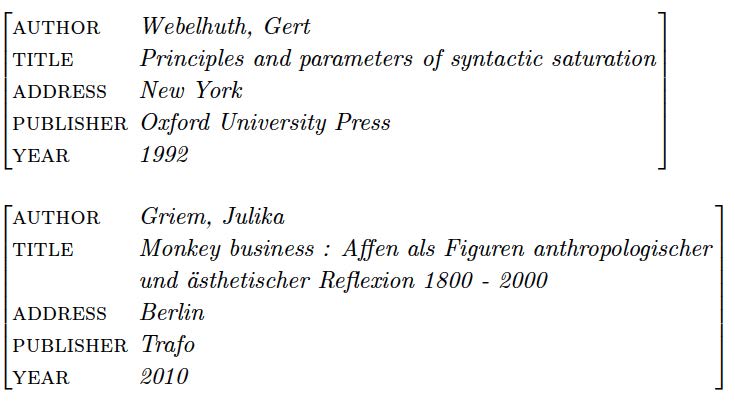
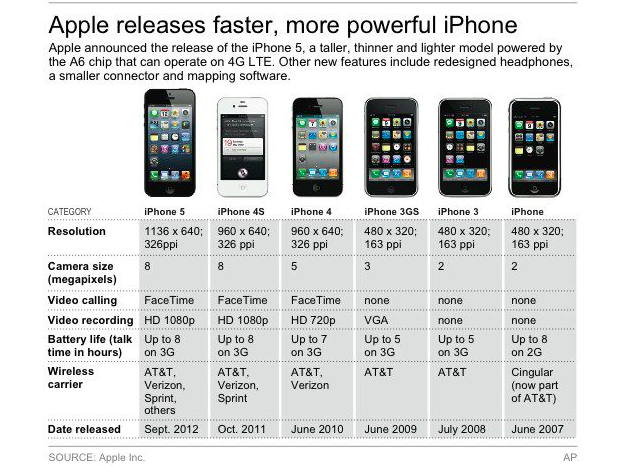
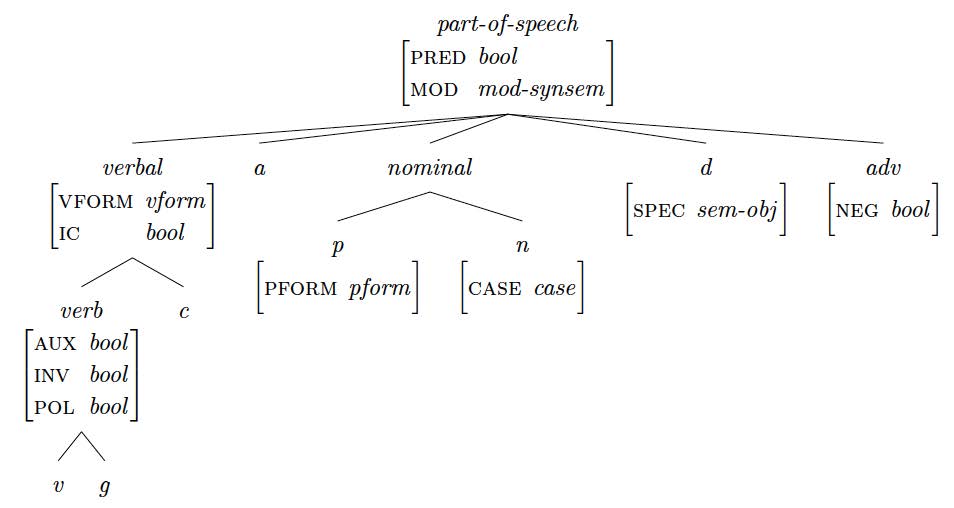
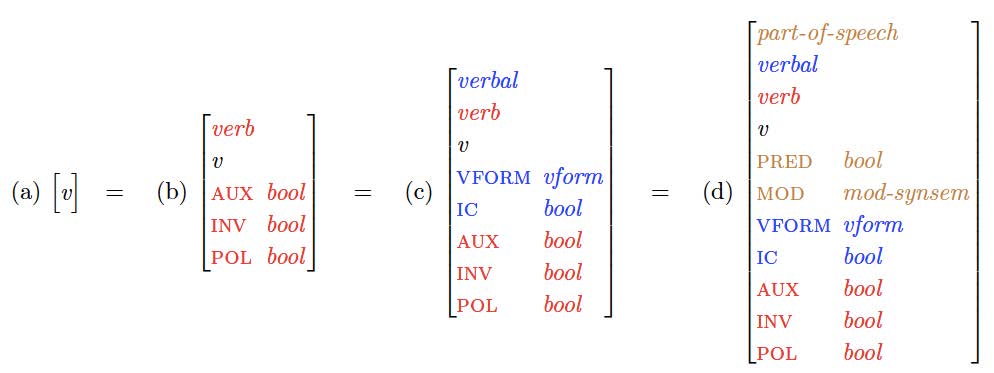

Establishing the head of a phrase
Establish what phrase the words below form and identify the head of the phrase!
Valence
2. Kim needs new shoes.
3. Kim talked to the student.
4. Kim sent the student to Robin.
5. Kim lent Robin a bicycle.
6. Kim told Robin that the student likes her.
7. Kim suggested to Robin that the student likes her.
8. Kim wants [to eat an apple.]
9. Kim believes Robin to like the student.
10. Kim seems to like the student.
11. Kim is intelligent.
12. Kim found the movie interesting.
13. Kim talked to Robin about the student.
14. Kim saw Robin talk to the student.
15. The student amuses Kim.
16. Kim came out of the room.
Words
| Verb |
SUBJ |
COMPS
|
| snore |
<NP> |
<>
|
| own |
<NP> |
<NP>
|
| put |
<NP> |
<NP,NP>
|
Verb SUBJ COMPS
snore <NP> <>
own <NP> <NP>
put <NP> <NP,PP>
When you look up the word scissors in the Oxford Learner's Dictionary, you are given the following information about it:
| Phonology |
scissors
|
| Part of speech |
noun
|
| Number |
plural
|
| Content |
a tool for cutting paper ...
|
The following representation shows how we will structure the information in a word in this course:
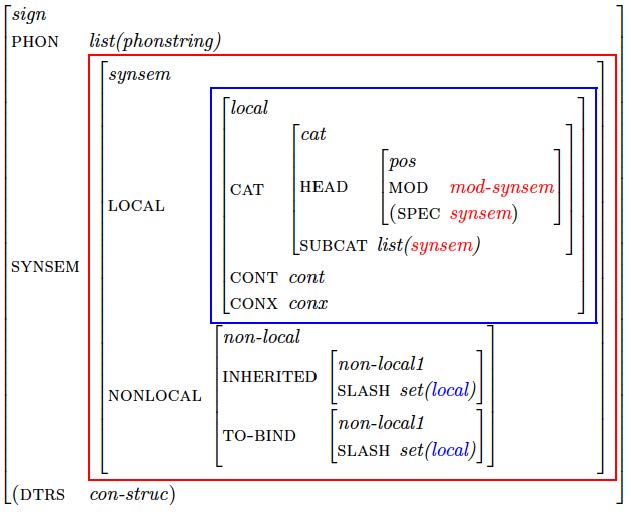
http://www.ello.uos.de/field.php/Syntax/Syntax
Parts of the clause
A video on constituent tests
A video on the concept grammar
Sentence meaning
<iframe width="420" height="315"
src="https://www.youtube.com/embed/JRiX8Jiq_Z4">
</iframe>
Quiz question types






